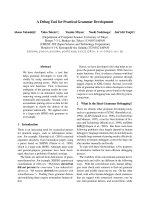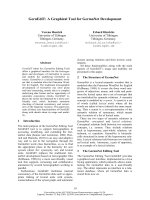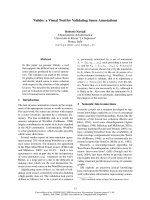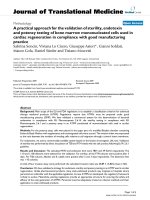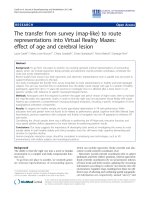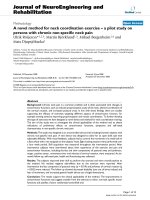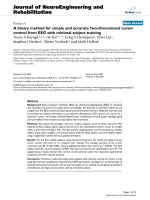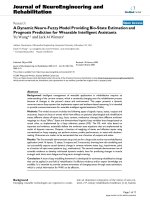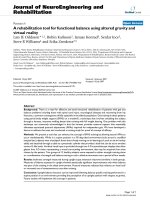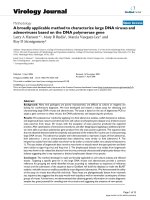báo cáo hóa học: " A rehabilitation tool for functional balance using altered gravity and virtual reality" potx
Bạn đang xem bản rút gọn của tài liệu. Xem và tải ngay bản đầy đủ của tài liệu tại đây (357.32 KB, 7 trang )
BioMed Central
Page 1 of 7
(page number not for citation purposes)
Journal of NeuroEngineering and
Rehabilitation
Open Access
Research
A rehabilitation tool for functional balance using altered gravity and
virtual reality
Lars IE Oddsson*
1,2
, Robin Karlsson
2
, Janusz Konrad
3
, Serdar Ince
3
,
Steve R Williams
4
and Erika Zemkova
2,5
Address:
1
Sister Kenny Rehabilitation Institute, Sister Kenny Research Center (12101), 800 E. 28th St. Minneapolis, MN 55407, USA,
2
NeuroMuscular Research Center, Boston University, 19 Deerfield Street, Boston, MA, 02215, USA,
3
Department of Electrical and Computer
Engineering, Boston University, 8 St Mary's Street, Boston, MA 02215, USA,
4
Department of Rehabilitation, Boston Medical Center One Boston
Medical Center Place, Boston, MA 02118, USA and
5
Department of Sports Medicine, Institute of Sport Sciences, Faculty of Physical Education and
Sports, Comenius University, Bratislava, Slovakia
Email: Lars IE Oddsson* - ; Robin Karlsson - ; Janusz Konrad - ;
Serdar Ince - ; Steve R Williams - ; Erika Zemkova -
* Corresponding author
Abstract
Background: There is a need for effective and early functional rehabilitation of patients with gait and
balance problems including those with spinal cord injury, neurological diseases and recovering from hip
fractures, a common consequence of falls especially in the elderly population. Gait training in these patients
using partial body weight support (BWS) on a treadmill, a technique that involves unloading the subject
through a harness, improves walking better than training with full weight bearing. One problem with this
technique not commonly acknowledged is that the harness provides external support that essentially
eliminates associated postural adjustments (APAs) required for independent gait. We have developed a
device to address this issue and conducted a training study for proof of concept of efficacy.
Methods: We present a tool that can enhance the concept of BWS training by allowing natural APAs to
occur mediolaterally. While in a supine position in a 90 deg tilted environment built around a modified
hospital bed, subjects wear a backpack frame that is freely moving on air-bearings (cf. puck on an air hockey
table) and attached through a cable to a pneumatic cylinder that provides a load that can be set to emulate
various G-like loads. Veridical visual input is provided through two 3-D automultiscopic displays that allow
glasses free 3-D vision representing a virtual surrounding environment that may be acquired from sites
chosen by the patient. Two groups of 12 healthy subjects were exposed to either strength training alone
or a combination of strength and balance training in such a tilted environment over a period of four weeks.
Results: Isokinetic strength measured during upright squat extension improved similarly in both groups.
Measures of balance assessed in upright showed statistically significant improvements only when balance
was part of the training in the tilted environment. Postural measures indicated less reliance on visual and/
or increased use of somatosensory cues after training.
Conclusion: Upright balance function can be improved following balance specific training performed in a
supine position in an environment providing the perception of an upright position with respect to gravity.
Future studies will implement this concept in patients.
Published: 10 July 2007
Journal of NeuroEngineering and Rehabilitation 2007, 4:25 doi:10.1186/1743-0003-4-25
Received: 16 January 2007
Accepted: 10 July 2007
This article is available from: />© 2007 Oddsson et al; licensee BioMed Central Ltd.
This is an Open Access article distributed under the terms of the Creative Commons Attribution License ( />),
which permits unrestricted use, distribution, and reproduction in any medium, provided the original work is properly cited.
Journal of NeuroEngineering and Rehabilitation 2007, 4:25 />Page 2 of 7
(page number not for citation purposes)
Background
Gait training using partial body weight support [1] (BWS)
is a neurorehabilitation technique that is becoming
increasingly popular and is being used to enhance loco-
motor recovery following a range of motor disorders asso-
ciated with stroke, spinal cord injury, cerebral palsy and
Parkinson's Disease as well as for early mobilization fol-
lowing total hip arthroplasty. Early mobilization follow-
ing any injury or disease that leads to immobility is crucial
for recovery and in the case of hip fractures, early ambula-
tion has even been shown to be directly predictive of
extended survival [2]. Initially proposed by [3] as a gait
retraining strategy for patients with neurological impair-
ment, the BWS approach was based on earlier work in the
cat [4,5] indicating its feasibility in humans. Although
work in this area is currently ongoing and the final word
on treatment effectiveness of this method is still out, sev-
eral recent studies show promising results. Improved
mobility following training with BWS has been demon-
strated in patients with spinal cord injury [6-8], stroke [9-
11], cerebral palsy [12] and Parkinson's disease [13] as
well as following total hip arthroplasty [11] and neck-of-
femur fracture [14]. However, it appears that improve-
ment in balance function following BWS training mainly
occurs in patients with minimal function prior to treat-
ment [10] suggesting that the BWS regimen is not suffi-
ciently challenging for more functional patients.
Consequently, the challenge to the balance system is
either too small to stimulate improvement or is not suffi-
ciently specific to balance function. In fact, differences
seen in muscle activity between gait during BWS and full
weight bearing at different velocities may reflect the
decreased need for balance control and absence of associ-
ated postural adjustments (APAs) during BWS gait [3,15].
One issue with the BWS technique that has not been com-
monly recognized is that the harness supporting the sub-
ject decreases the need for natural APAs that are required
for independent gait. The main site for an active control of
balance during gait is the step-to-step mediolateral place-
ment of the foot [16-18]. When supported by a harness
during BWS training any mediolateral movement is
restricted by a medially directed reaction force component
that will help stabilize the body in the frontal plane and
decrease or even eliminate the need for APAs. This restric-
tion may limit the full advantage of unloaded gait train-
ing. To address this issue, we have designed a system that
can refine the concept of BWS training by allowing natural
APAs to occur spontaneously. We propose that unloaded
gait training is more effective if APAs are allowed. In a
pilot study we have demonstrated that upright balance
function improves after training in a small (8 × 8 × 8 feet)
90 deg tilted room with the subject in a supine position
strapped to a device (freely moving on air-bearings, cf.
puck on an air hockey table, Figure 1, left). The room con-
tained familiar objects providing a perception of being
upright in an upright environment [19]. A G-like load was
provided with a weight stack [20,21]. For movements in
the frontal plane, this tilted environment requires the sub-
ject to perform APAs as if in an upright environment. No
postural control is required for sagittal plane movements.
A video of a subject exercising in this tilted room appears
to a blinded viewer as being upright with normal frontal
plane APAs to balance against gravity. Here we describe a
similar system that is intended to be moveable for use in
a clinical setting. Instead of a physical room, subjects view
two 3-D automultiscopic displays that allow 3-D vision
without any special glasses [22,23]. The screens represent
windows to a virtual surrounding environment that may
be acquired from sites chosen by the patient. We also
present data from a training study conducted in the tilted
room environment with two groups of healthy subjects.
The goal of the training study was to demonstrate that
training in the tilted environment can improve aspects of
upright strength and balance function concurrently, a
concept that could provide early functional rehabilitation
for patients as well as become an effective countermeasure
for training of astronauts in preparation for lunar and/or
Mars missions.
Methods
Participants and Procedures
Two groups of healthy subjects; 1) Strength and Balance
Training (S&B, 6 female+6 male, 20–21 yrs, 170.1 ± 9.2
cm, 68.6 ± 10.8 kg) and; 2) Strength Training (S, 5
female+ 6 male, 19–25 yrs, 173.5 ± 9.0 cm, 68.7 ± 10.8
kg) participated in the study. The project was approved by
the Boston University Charles River Campus IRB. The S&B
group performed "squats" in the tilted room environment
(Figure 1, left) [21] on a balance board that required them
to balance in the mediolateral direction, whereas the S
group performed squats without balance requirement
(sliding on fixed rails and no balance board). The strength
program was progressive (50%–75% of 1RM) and each
session consisted of 6 sets of 10 reps.
The following measures were conducted before and after
training; 1) Maximal Voluntary Contraction (MVC) dur-
ing an isokinetic squat extension (10 deg/s & 35 deg/s)
using a computerized exercise system (CES, Ariel Dynam-
ics, CA, USA); 2) Stationary stance on one leg with eyes
open and with eyes closed while standing on a force plat-
form. Ten trials of 30s standing were performed under
each condition. Subjects rested between as needed
between trials to minimize effects of fatigue. Subjects were
instructed to stand as still as possible during each trial and
to actively minimize their perceived body sway. Center of
pressure (COP) data were recorded at 100 Hz. Summary
statistics and Stabilogram-Diffusion parameters were
extracted from the COP data [24].
Journal of NeuroEngineering and Rehabilitation 2007, 4:25 />Page 3 of 7
(page number not for citation purposes)
Results
Strength and Balance Training in a Tilted Room
Environment
Figure 2 shows maximum isokinetic strength before and
after training in the tilted environment for the two groups.
Both the S&B and the S groups showed statistically signif-
icant improvements in MVC during both isokinetic veloc-
ities. Improvements at the higher velocity appeared
Tilted Room environment (left) and moveable system for functional neurorehabilitation (right)Figure 1
Tilted Room environment (left) and moveable system for functional neurorehabilitation (right). Left: Tilted
Room environment used for training study. The subject wears a back-pack frame with air-bearings allowing friction free medi-
olateral motion. The frame is attached to a weight stack that provides a gravity-like load that the subject must balance against.
The room contains common physical objects that have a visual "polarity" with respect to gravity, i.e. we commonly align their
position with gravity thereby enhancing the perception of being upright in an upright environment. Right: In the moveable bed
system the subject views two large automultiscopic LCD screens that project 3-D images. The screens represent windows in a
virtual room surrounding the subject. Images can be from the patient's own home, country house etc. Note that treadmill is
not shown in schematic.
Journal of NeuroEngineering and Rehabilitation 2007, 4:25 />Page 4 of 7
(page number not for citation purposes)
marginally larger for the S group (Figure 2). Several sub-
jects in the S&B group reported subjectively that they per-
ceived improvement in their ability to control posture
following the training. Measures of balance control con-
firmed such an improvement. Overall, effects on postural
parameters were mainly seen in the mediolateral direc-
tion, specific to the direction of postural challenge in the
tilted room during training. Figure 3 shows the medi-
olateral critical time parameter for eyes-closed conditions
from the stabilogram-diffusion analysis. This parameter
indicates the time interval at which, on average, the ran-
dom walk behaviour of the COP changes from being pre-
dominantly persistent (tendency to continue in the same
direction) to being predominantly antipersistent (ten-
dency to reverse direction). The critical time parameter
was 105 ms shorter after training for the S&B group (p <
0.05, Figure 3) with a non-significant decrease of 9 ms in
the S group. A similar, although non-significant, decrease
was seen with eyes open in the S&B group (p < 0.14).
The combined S&B training appeared to alter the relation-
ship between balance performances under eyes closed vs.
eyes open (Romberg ratio). The Critical Displacement
parameter, indicating the average COP displacement at
which the postural control process becomes mainly anti-
persistent, was five times higher under eyes closed com-
pared to eyes open pre-training for the S&B group and
decreased by 30% to 3.5 post-training (p < 0.04). There
was a small non-significant decrease in the S group (6%).
A post-training decrease in the S&B group of 21% (p <
0.03) was seen for the ratio between mediolateral short-
term diffusion coefficients indicating a relatively lower
short-term stochastic activity under eyes closed conditions
as a result of the training. This was mainly related to a
40% increase in mediolateral short-term stochastic activ-
ity under open eyes conditions (p < 0.012). No change
was observed for the S group.
Discussion
The current project has demonstrated the feasibility of a
novel moveable clinical device intended for functional
rehabilitation of strength and balance in a wide range of
categories of patients. The system allows natural medi-
olateral APAs to occur across a wide range of gravity-like
loads, an important balance related stimulus that cur-
rently used BWS systems cannot provide. Consequently,
the system would complement currently used technolo-
gies by providing a unique training stimulus that is of
importance for independent upright stance and gait. An
additional benefit of the system when compared to inde-
pendent upright gait training is that loss of balance will
not lead to a fall. Therefore, frail patients who are at high
risk of re-injury in case of a fall during upright rehabilita-
tion would be able to perform balance rehabilitation,
independently with no assistive devices (canes, walker or
support bars), no risk of a fall and minimal risk of injury.
Allowing such patients to stand and/or walk independ-
Pre- and post-training results of the mediolateral critical time parameterFigure 3
Pre- and post-training results of the mediolateral
critical time parameter. Changes in the mediolateral crit-
ical time parameter under eyes-closed conditions are shown
for the S&B group (Left) and the S group (Right). Graphs rep-
resent mean with bars indicating+ 1 standard deviation of the
mean. A statistically significant change was only seen in the
S&B group.
0
0.25
0.5
0.75
1
Pre Post Pre Post
S&B S
Uni-pedal Mediolateral Critical Time (s)
*
p < 0.05
Pre- and post-training data of MVCFigure 2
Pre- and post-training data of MVC. White and black
graphs show pre-test MVC values for the S&B and S groups
during slow (10 deg/s, left) and fast (35 deg/s, right) isokinetic
squat extension, respectively. Similarly, cross-hatched and
striped graphs show post test MVC values for S&B and S
groups, respectively. Graphs represent mean with bars indi-
cating+ 1 standard deviation of the mean. All pre- to post-
training changes were statistically significant.
0
500
1000
1500
2000
Pre Post Pre Post Pre Post Pre Post
10 DEG/S 35 DEG/S
SQUAT MVC (N)
*
p < .013
*
p < .006
*
p < .027
*
p < .038
S&B S S&B S
Journal of NeuroEngineering and Rehabilitation 2007, 4:25 />Page 5 of 7
(page number not for citation purposes)
ently in a safe setting may in addition to improve their
physical functioning also help rebuild their confidence
and therefore decrease their fear of falling and quality of
life.
The results from our training study have shown, using
healthy individuals, that upright strength and balance
function improves concurrently following combined
strength and balance training in a 90 degree tilted envi-
ronment. Strength training alone did not improve balance
function. It is of particular interest that balance function
improved since vestibular information from the otolith
organ, that normally provides tilt orientation information
with respect to gravity, cannot provide any relevant such
information when balancing in the tilted environment.
Consequently, any balance improvement must have been
related to enhanced use of somatosensory, visual and/or
linear and angular acceleration information from the ves-
tibular system. The shorter critical time parameter of the
Stabilogram-Diffusion analysis seen after training in the
S&B group would suggest that these enhancements
allowed implementation of postural corrections that
where, on average, 105 ms quicker than before training.
Conclusion
These results support the view that combined strength and
balance training in the tilted environment, where the ves-
tibular tilt orientation mechanism cannot be used for bal-
ancing, can improve balance function during upright
while balancing against gravity in addition to muscular
strength. This is important to know when designing reha-
bilitation programs for patients who are candidates for
this kind of training. In addition, this indicates that astro-
nauts training in-flight under microgravity conditions can
target postural control and may improve training effi-
ciency by a multimodal regimen where strength training is
performed under conditions where balance is challenged.
Future Plans – Moveable Clinical System for Functional
Neurorehabilitation
System Description
Figure 1 (lower row) shows two photographs of the
recently developed system; the system on its own (left)
and with a subject while walking on the permanently fas-
tened motorized treadmill (right). Notice that the picture
has been rotated 90 degrees to convey a visual effect of
upright gait. A flat floor surface allowing various standing
exercises can be placed over the treadmill belt. For exam-
ple, a custom built balance board can be attached to the
floor board through a high grade door hinge with a
removable pin. The wheel base of a regular hospital bed
has been modified to hold a pneumatic force actuator, a
flat friction free surface that supports a back pack frame
with air bearings, a visual surround system and a portable
air-compressor. Subjects wear a sturdy low weight alumi-
num back pack frame (Aruc Systems LLC, Eau Claire, WI)
mounted with three air bearings (NewWay Airbearings
Aston, PA) that allow the subject friction-free movement
in the frontal plane. A cable attached to the lower part of
the frame runs between the legs of the subject to a pulley
mounted on a linear bearing allowing mediolateral
motion of the pulley before connecting to the pneumatic
actuator. The bearings are porous, 2 1/2" in diameter and
can support ~175 lbs each at 60 psi with 10 micron lift.
Porous air bearings, typically made with carbon, provide
an almost uniform air pressure across the entire bearing
surface. The carbon surface also provides greater bearing
protection if there is an air supply failure, and allows the
bearings to be moved during air failure without damaging
the support surface. The support surface consists of a 1
inch thick styrene plate sandwiched between 1/16th inch
thick aluminum sheets. The pneumatic actuator can pro-
vide up to ~300 lbs of force at 50 psi air pressure. Air sup-
port can either be provided externally or from an on-
board dental air compressor (Bambi Air Compressors Ltd,
Birmingham, UK).
Three-Dimensional Display Techniques
Visual cues to convey a perception of being in an upright
environment are provided through state of the art display
techniques with 3-D images of a virtual environment.
Typically, stereoscopic 3-D displays require polarized or
shutter glasses to deliver the projected images separately
to each eye. Inconvenience, often discomfort, and, in the
case of shutter glasses, cost, are some of the reasons that
eyewear-based 3-D displays are far from practical. Addi-
tionally, stereoscopic systems render 3-D environment
from one single viewpoint thus making any viewer move-
ment in front of the screen unnatural (static 3-D objects
rotate with lateral head motion). Recently, a new type of
3-D displays, called automultiscopic, have been devel-
oped [22,23]. Such displays require no glasses and project
multiple views; a viewer can clearly experience depth and
even see a little around objects. These displays are capable
of projecting several, typically 9, views of a 3-D scene. The
current system uses two displays from Stereographics
Corp (Synthagram SG222, resolution 3840 × 2400 pixels
and Synthagram SG202, resolution 1600 × 1200 pixels),
one placed in front of the subject and one on the side.
When still images displayed on these screens they are
intended to represent virtual "windows" to an outside
environment and thereby promote a visually induced reo-
rientation illusion where subjects perceive themselves as
being upright with respect to gravity [19-21].
Instead of using nine cameras to generate 3-D images
fewer cameras are commonly used and missing views are
reconstructed by means of multi-dimensional signal
processing. The nine views are then combined together in
a process called "interzigging". An enhanced algorithm,
Journal of NeuroEngineering and Rehabilitation 2007, 4:25 />Page 6 of 7
(page number not for citation purposes)
incorporating two-dimensional lowpass filtering to elimi-
nate spatial aliasing has recently been developed [25]. The
fundamental issue in capturing 3-D information and then
rendering it on a 3-D screen is to accurately measure the
scene depth or disparity, the latter defined as a vector in the
image plane that connects projections of the same 3-D
feature in both views. Given camera parameters (baseline,
focal length), depth can be computed from disparity and
vice versa. The estimation of disparity is typically achieved
by assuming an invariant property, such as brightness or
color, and then establishing correspondence between
images based on this property [26-28]. Additional work
by Konrad [25,29-31] has addressed these issues. Based
on disparities between two calibrated views, depth (struc-
ture) of the captured 3-D scene can be computed which,
in turn, permits the reconstruction of views from virtual
cameras. Reconstruction based on 2 views is a well-
researched problem [32-35].
The system depicted in Figure 1 (lower row) has been
built and pilot tested for functionality during gait on the
attached treadmill, standing on one and two legs on the
floor surface and while balancing on the balance board.
G-load can be varied continuously and the Bambi com-
pressor can provide airflow simultaneously to the air bear-
ings and the pneumatic actuator. The system can easily be
moved and handled by one person and is as wide as a reg-
ular hospital bed.
Competing interests
Dr. Oddsson is the inventor on a provisional patent filed
by Boston University on the technology presented in this
manuscript. There are no other competing interests.
Authors' contributions
LO conceived and designed the moveable bed device,
designed the training study and drafted the manuscript.
RK participated in the design of the moveable bed device
and the tilted room, and has built the moveable bed sys-
tem. JK and SI developed and designed software algo-
rithms for displaying 3D images on the automultiscopic
screens used in the moveable bed device and they helped
write the manuscript. SW participated in design aspects of
the moveable bed device with particular focus on patient
compliance and relevance for clinical implementation. EZ
participated in the design of the training study, data acqui-
sition as well as analysis and interpretation. All authors
read and approved the manuscript.
Acknowledgements
Support was provided by NIH (5R21HD050655-02), a NASA Cooperative
Agreement NCC 9-58 with the National Space Biomedical Research Insti-
tute and a Fulbright Fellowship (Dr. Zemkova).
References
1. Norman KE, Pepin A, Ladouceur M, Barbeau H: A treadmill appa-
ratus and harness support for evaluation and rehabilitation
of gait. Arch Phys Med Rehabil 1995, 76:772-778.
2. Kamel HK, Iqbal MA, Mogallapu R, Maas D, Hoffmann RG: Time to
ambulation after hip fracture surgery: relation to hospitali-
zation outcomes. J Gerontol A Biol Sci Med Sci 2003, 58:1042-1045.
3. Finch L, Barbeau H, Arsenault B: Influence of body weight sup-
port on normal human gait: development of a gait retraining
strategy. Phys Ther 1991, 71:842-55; discussion 855-6.
4. Lovely RG, Gregor RJ, Roy RR, Edgerton VR: Effects of training on
the recovery of full-weight-bearing stepping in the adult spi-
nal cat. Exp Neurol 1986, 92:421-435.
5. Barbeau H, Rossignol S: Recovery of locomotion after chronic
spinalization in the adult cat. Brain Res 1987, 412:84-95.
6. Visintin M, Barbeau H: The effects of body weight support on
the locomotor pattern of spastic paretic patients. Can J Neurol
Sci 1989, 16:315-325.
7. Dobkin BH, Apple D, Barbeau H, Basso M, Behrman A, Deforge D,
Ditunno J, Dudley G, Elashoff R, Fugate L, Harkema S, Saulino M, Scott
M: Methods for a randomized trial of weight-supported
treadmill training versus conventional training for walking
during inpatient rehabilitation after incomplete traumatic
spinal cord injury. Neurorehabil Neural Repair 2003, 17:153-167.
8. Barbeau H, Norman K, Fung J, Visintin M, Ladouceur M: Does neu-
rorehabilitation play a role in the recovery of walking in neu-
rological populations? Ann N Y Acad Sci 1998, 860:377-392.
9. Werner C, Bardeleben A, Mauritz KH, Kirker S, Hesse S: Treadmill
training with partial body weight support and physiotherapy
in stroke patients: a preliminary comparison. Eur J Neurol
2002, 9:639-644.
10. Barbeau H, Visintin M: Optimal outcomes obtained with body-
weight support combined with treadmill training in stroke
subjects. Arch Phys Med Rehabil 2003, 84:1458-1465.
11. Hesse S, Werner C, Seibel H, von Frankenberg S, Kappel EM, Kirker
S, Kading M: Treadmill training with partial body-weight sup-
port after total hip arthroplasty: a randomized controlled
trial. Arch Phys Med Rehabil 2003, 84:1767-1773.
12. Schindl MR, Forstner C, Kern H, Hesse S: Treadmill training with
partial body weight support in nonambulatory patients with
cerebral palsy. Arch Phys Med Rehabil 2000, 81:301-306.
13. Miyai I, Fujimoto Y, Yamamoto H, Ueda Y, Saito T, Nozaki S, Kang J:
Long-term effect of body weight-supported treadmill train-
ing in Parkinson's disease: a randomized controlled trial.
Arch Phys Med Rehabil 2002, 83:1370-1373.
14. Baker PA, Evans OM, Lee C: Treadmill gait retraining following
fractured neck-of-femur. Arch Phys Med Rehabil 1991, 72:649-652.
15. Sullivan KJ, Knowlton BJ, Dobkin BH: Step training with body
weight support: effect of treadmill speed and practice para-
digms on poststroke locomotor recovery. Arch Phys Med Reha-
bil 2002, 83:683-691.
16. Bauby CE, Kuo AD: Active control of lateral balance in human
walking. J Biomech 2000, 33:1433-1440.
17. Oddsson LI, Wall C, McPartland MD, Krebs DE, Tucker CA: Recov-
ery from perturbations during paced walking. Gait Posture
2004, 19:24-34.
18. Wall C 3rd, Oddsson LI, Patronik N, Sienko K, Kentala E: Recovery
trajectories of vestibulopathic subjects after perturbations
during locomotion. J Vestib Res 2002, 12:239-253.
19. Howard IP, Hu G: Visually induced reorientation illusions. Per-
ception 2001, 30:583-600.
20. Oddsson LIE, Wall IIIC: A concept for balance training in space
- A pilot study [abstract]. J Vestib Res 2002, 12:239.
21. Oddsson LIE, III CW, Meyer PF, Konrad J: A virtual environment
with simulated gravity for balance rehabilitation of bedrid-
den patients and frail individuals [abstract].
Proceedings XVth
Congress of the International Society of Electrophysiology and Kinesiology
2004:55.
22. Schmidt A, Grasnick A: Multi-viewpoint autostereoscopic dis-
plays from 4D-Vision. Proc SPIE Stereoscopic Displays and Virtual
Reality Systems 2002, 4660:212-221.
23. Lipton L, Feldman M: A new stereoscopic display technology:
The SynthaGram. Proc SPIE Stereoscopic Displays and Virtual Reality
Systems 2002, 4660:229-235.
Publish with BioMed Central and every
scientist can read your work free of charge
"BioMed Central will be the most significant development for
disseminating the results of biomedical research in our lifetime."
Sir Paul Nurse, Cancer Research UK
Your research papers will be:
available free of charge to the entire biomedical community
peer reviewed and published immediately upon acceptance
cited in PubMed and archived on PubMed Central
yours — you keep the copyright
Submit your manuscript here:
/>BioMedcentral
Journal of NeuroEngineering and Rehabilitation 2007, 4:25 />Page 7 of 7
(page number not for citation purposes)
24. Meyer PF, Oddsson LI, De Luca CJ: The role of plantar cutaneous
sensation in unperturbed stance. Exp Brain Res 2004,
156:505-512.
25. Konrad J, Agniel P: Subsampling models and anti-alias filters for
3-D automultiscopic displays: Jan. 2006, 15:128-140.
26. Jenkin MRM, Jepson AD, Tsotsos JK: Techniques for disparity
measurements. CVGIP: Image Underst 1991, 53:14-30.
27. Grammalidis N, Strintzis MG: Disparity and occlusion estimation
in multiocular systems and their coding for the communica-
tion of multiview image sequences. IEEE Trans Circuits Syst Video
Technol 1998, 8:328-344.
28. Redert A, Hendriks E, Biemond J: Correspondence estimation in
image pairs. IEEE Signal Process Mag 1999, 16:29-46.
29. Konrad J, Dubois E: Bayesian estimation of motion vector
fields. IEEE Trans Pattern Anal Machine Intell 1992, 14:910-927.
30. Dubois E, Konrad J: Estimation of 2-D motion fields from image
sequences with application to motion-compensated process-
ing. In Motion Analysis and Image Sequence Processing Edited by: Lagen-
dijk MISRL. , Kluwer Academic Publishers; 1993:53-87.
31. Chahine M, Konrad J: Motion-compensated interpolation using
trajectories with acceleration. Proc SPIE Digital Video Compression:
Algorithms and Technology 1995, 2419:152-163.
32. Skerjanc R, Liu J: A three camera approach for calculating dis-
parity and synthesizing intermediate pictures. Signal Process,
Image Commun 1991, 4:55-64.
33. Konrad J, Lan ZD: Dense disparity estimation from feature
correspondences. Proc SPIE Stereoscopic Displays and Virtual Reality
Systems 2000, 3957:90-101.
34. Konrad J: Enhancement of viewer comfort in stereoscopic
viewing: parallax adjustment. Proc SPIE Stereoscopic Displays and
Virtual Reality Systems 1999,
3639:179-190.
35. Mansouri AR, Konrad J: Bayesian winner-take-all reconstruc-
tion of intermediate views from stereoscopic images. IEEE
Trans Image Process 2000, 9:1710-1722.
